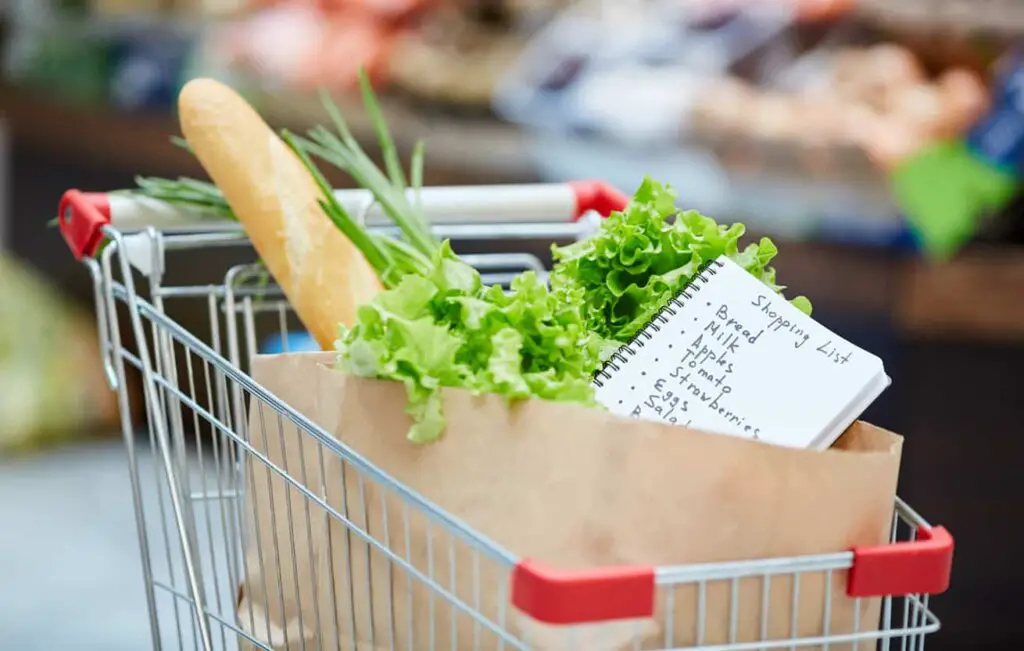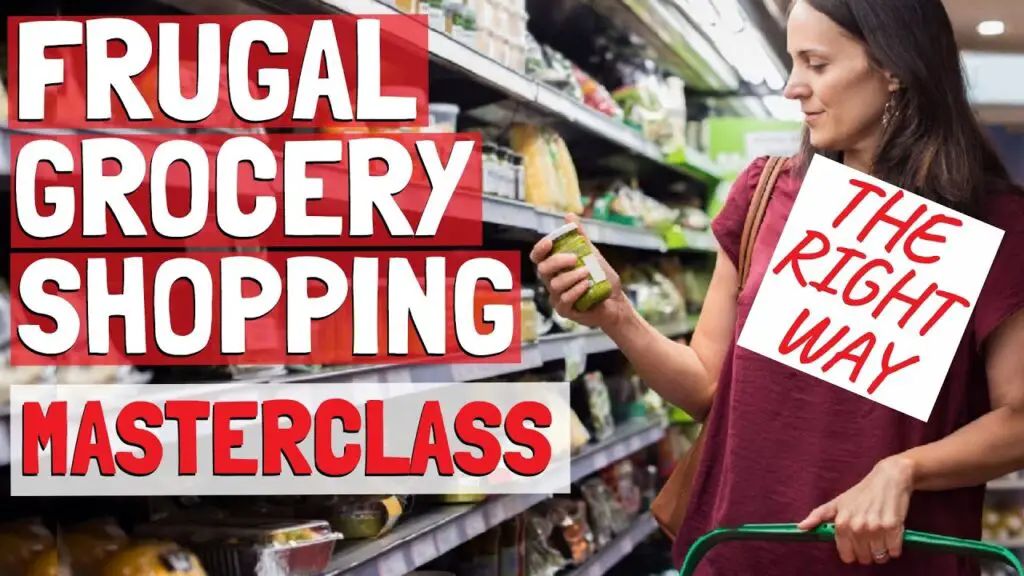Introduction
Welcome to the Ultimate Frugal Guide: Grocery Shopping Edition! As someone who is passionate about living a frugal lifestyle, I am excited to share with you some valuable insights and strategies for saving money on your grocery bills. In this guide, we will explore the concept of frugality and its importance in grocery shopping.
Understanding the concept of frugality
Frugality is more than just being thrifty or careful with money. It is a mindset that enables us to make intentional choices about our spending habits and prioritize our financial well-being. Being frugal means seeking value, making informed decisions, and avoiding unnecessary expenses. When it comes to grocery shopping, adopting a frugal mindset can significantly impact our budgets and overall savings.
The importance of frugal grocery shopping
Grocery shopping is one area where we can easily overspend if we’re not intentional about our choices. By being mindful of our spending and adopting frugal habits, we can significantly reduce our grocery bills without sacrificing the quality of our meals. Frugal grocery shopping is all about planning ahead, making a shopping list, comparing prices, opting for generic or store-brand products, and taking advantage of sales and discounts.
When we practice frugality in our grocery shopping, we not only save money, but we also minimize food waste, make healthier choices, and support local businesses. Moreover, being frugal allows us to have more financial freedom and flexibility in other areas of our lives.
By following the tips and strategies outlined in this guide, you will learn how to make the most out of your grocery shopping trips while maximizing savings. So, let’s dive in and discover the art of frugal grocery shopping together!

A Frugal Guide to Grocery Shopping
Welcome to the Ultimate Frugal Guide: Grocery Shopping Edition! In this post, I will share valuable tips and strategies to help you save money on your grocery bill. By planning ahead and adopting a frugal mindset, you can make a significant impact on your monthly expenses. So let’s dive in!
Planning Ahead
Creating a grocery budget
The first step to being frugal in your grocery shopping is setting a realistic budget. Take a look at your monthly income and expenses, and determine how much you can allocate for groceries. Be sure to consider any upcoming events or special occasions that may require additional spending. By setting a budget, you can stay focused and avoid impulse buys.
Making a shopping list
Once you have your budget in place, it’s time to create a shopping list. Before heading to the store, take inventory of what you already have in your pantry and fridge. This will help you avoid buying duplicates and wasting food. Jot down the essentials you need for your meals and snacks, and stick to the list when you shop. A well-planned list will keep you on track and prevent unnecessary spending.
Meal planning for cost-effective shopping
Meal planning is a frugal shopper’s secret weapon. By knowing in advance what meals you’ll be preparing for the week, you can make the most out of your grocery purchases. Look for sales and discounts on ingredients that align with your meal plan. Consider batch cooking and freezing leftovers for future meals. Not only does this save money, but it also saves you time in the kitchen!
By following these tips for planning ahead, you can become a savvy and frugal grocery shopper. Stay tuned for the next section of our Ultimate Frugal Guide: Grocery Shopping Edition, where we will explore the art of comparison shopping and how to make the most out of coupons and reward programs. Happy saving!

Smart Shopping Strategies
When it comes to grocery shopping on a budget, it’s essential to have some savvy strategies up your sleeve. By being smart and strategic with your purchases, you can save a significant amount of money without compromising on the quality of the items you buy. In this section, I will share some valuable tips and tricks that will help you make the most out of your grocery shopping experience.
Comparing prices and brands
One of the simplest ways to save money at the grocery store is by comparing prices and brands. Before heading out to the store, take some time to do a little research and compare prices at different supermarkets. Don’t forget to consider the quality of the products as well. Sometimes, paying a bit more for a trusted brand might be worth it in terms of taste and overall satisfaction.
Using coupons and discounts
Coupons and discounts are proven money-savers when it comes to grocery shopping. Keep an eye out for coupons in newspapers, magazines, and online platforms. Many grocery stores also offer loyalty programs, which can earn you additional discounts and exclusive offers. By utilizing these savings opportunities, you can significantly trim down your grocery bill.
Shopping during sales and promotions
Timing is everything when it comes to grocery shopping on a budget. Keep an eye out for sales and promotions, as many grocery stores regularly offer discounts on certain items. Plan your shopping trips accordingly, stock up on non-perishable items, and take advantage of these special deals to maximize your savings.
Buying in bulk for savings
Buying in bulk is another fantastic way to stretch your dollar further. When purchasing non-perishable items like rice, beans, pasta, and canned goods, buying in larger quantities often results in significant savings. Just make sure you have enough storage space at home and consider the expiration dates to ensure you can consume the products before they go bad.
By implementing these smart shopping strategies, you can make a significant impact on your grocery expenses without sacrificing the quality of your purchases. Remember, a little planning and thoughtfulness can go a long way in saving money on groceries. So, go ahead and put these strategies into action during your next shopping trip!

Navigating the Store
When it comes to grocery shopping on a budget, knowing how to effectively navigate the store can make all the difference. In this section, I will share some valuable tips and tricks that will help you maximize your savings while still getting all the items on your shopping list.
Exploring different grocery stores
One of the first steps in becoming a frugal grocery shopper is to survey the different grocery stores in your area. Take the time to visit various supermarkets and compare prices. Look out for any ongoing promotions or discounts that may be available. By exploring different options, you can identify the stores that offer the best deals on the products you consume regularly.
Understanding store layouts
Understanding the layout of the store is another key aspect of frugal shopping. Familiarize yourself with the store’s organization, paying attention to where the most affordable items are located. Often, generic or store-brand items can be found on lower shelves or in less prominent sections. Additionally, certain aisles tend to house more expensive products, such as name-brand items or specialty goods. By knowing these patterns, you can easily navigate the store and save money by opting for the more affordable options.
Avoiding impulse purchases
One of the biggest challenges when grocery shopping is resisting the temptation of impulse purchases. Stores strategically place enticing items near the checkout counters or in prominent displays to lure shoppers into buying items they don’t actually need. To combat this, always shop with a list and stick to it. Additionally, avoid grocery shopping while hungry, as it can lead to impulsive decisions and unnecessary spending.
As a frugal shopper, navigating the store effectively is crucial. By exploring different grocery stores, understanding store layouts, and avoiding impulse purchases, you can maximize your savings and make every trip to the grocery store a success. Happy shopping!

Choosing Cost-Effective Foods
Prioritizing Fresh and Seasonal Produce
When it comes to grocery shopping on a budget, one of the best strategies is to prioritize fresh and seasonal produce. Not only is fresh produce generally more affordable than processed or packaged options, but it’s also healthier and tastier. I always make sure to check out the local farmer’s market or grocery store flyer to find out what fruits and vegetables are in season. By doing so, I can take advantage of lower prices and fresher options.
Opting for Generic or Store-Brand Items
Another way to save money at the grocery store is by opting for generic or store-brand items. These products are often comparable in quality to name brands but at a fraction of the cost. I have found that most generic items, such as spices, canned goods, and even pantry staples like flour and sugar, work just as well as their pricier counterparts. By being open to trying different brands, I am able to significantly reduce my grocery bill without sacrificing taste or quality.
Evaluating Unit Prices for Better Value
One aspect of grocery shopping that many people overlook is evaluating unit prices. This is especially important when comparing different sizes or brands of the same product. Sometimes, a larger package may seem like a better deal, but when you calculate the unit price, you may discover that a smaller package actually offers better value. Taking a few extra seconds to do the math can save you money in the long run. I always make it a point to compare unit prices and select the option that gives me the most bang for my buck.
choosing cost-effective foods is essential for frugal grocery shopping. By prioritizing fresh and seasonal produce, opting for generic or store-brand items, and evaluating unit prices, you can stretch your grocery budget further while still enjoying delicious and nutritious meals. So, next time you head to the store, keep these tips in mind and watch your savings grow. Happy shopping!
Minimizing Food Waste
I believe that one of the most effective ways to live a frugal lifestyle is to minimize food waste. By being mindful of expiration dates, properly storing perishable foods, and utilizing leftovers and meal prepping, we can make the most out of our groceries and, in turn, save money.
Understanding expiration dates
It’s essential to understand the different types of expiration dates placed on food products. Often, there is confusion between “best-by,” “sell-by,” and “use-by” dates. The “best-by” date indicates the date by which the product is at its highest quality, but it doesn’t mean it’s no longer safe to consume. The “sell-by” date is the recommended date for stores to sell the product, but it doesn’t necessarily indicate its freshness. The “use-by” date refers to the last date recommended for use while ensuring optimal taste and quality. By understanding these dates, we can avoid unnecessarily throwing away perfectly good food.
Properly storing perishable foods
To maximize the shelf life of perishable foods, it’s important to store them correctly. For example, refrigerating fruits and vegetables, except for bananas and tomatoes, can help them stay fresh for longer. Items like bread, milk, and eggs should be stored in the refrigerator’s designated compartments to maintain freshness. Additionally, properly sealing and labeling leftovers can extend their lifespan and ensure they remain safe to consume.
Utilizing leftovers and meal prepping
Leftovers are a frugal shopper’s best friend. Instead of throwing them away, we can get creative with meal planning. By repurposing leftovers into new dishes or incorporating them into lunch options for the week, we can save money and reduce waste. Meal prepping is another valuable tool in minimizing food waste. By preparing meals in advance and portioning them out, we can avoid impulsive purchases and make the most of our groceries throughout the week.
by understanding expiration dates, properly storing perishable foods, and utilizing leftovers and meal prepping, we can significantly reduce food waste and save money in the process. Being mindful of our groceries is not only good for our wallets but also for the environment. So let’s start implementing these practices and embrace the frugal lifestyle!

Utilizing Loyalty Programs
One of the best ways to save money on grocery shopping is by taking advantage of loyalty programs offered by grocery stores. These programs are designed to reward customers for their loyalty and can provide substantial savings on your grocery bill. In this section, I will explain how to effectively utilize these programs to maximize your frugal lifestyle.
Signing up for store loyalty programs
The first step in utilizing loyalty programs is signing up for them. Most grocery stores offer free membership, which only requires filling out a simple form with your basic information. Once you have signed up, you will typically be given a loyalty card that you can use during your shopping trips.
Utilizing loyalty card benefits
Once you have your loyalty card, make sure to bring it with you every time you go grocery shopping. By scanning your card at the checkout, you can take advantage of exclusive benefits such as discounted prices, personalized coupons, and even cash back offers. These benefits can add up over time and save you a significant amount of money.
Taking advantage of member-only discounts
Another perk of loyalty programs is access to member-only discounts. Many grocery stores offer special promotions and sales exclusively for their loyalty program members. Keep an eye out for these discounts and plan your shopping accordingly to take full advantage of the savings.
signing up for store loyalty programs and utilizing their benefits is an essential aspect of frugal grocery shopping. By taking advantage of these programs, you can unlock exclusive discounts, personalized offers, and cash back rewards. So the next time you head to the grocery store, don’t forget to bring your loyalty card and enjoy the savings!
Diversifying Shopping Resources
Exploring local farmer’s markets
One of the best ways to save money on groceries is by exploring the diverse range of shopping resources available in your area. A great place to start is by visiting local farmer’s markets. These markets offer a wide variety of fresh produce, often at lower prices than traditional grocery stores. Not only will you be supporting local farmers and businesses, but you will also have the opportunity to try unique and seasonal fruits, vegetables, and artisanal products. I personally love the vibrant atmosphere and the chance to chat with the growers themselves, who are often eager to share tips and recipes.
Considering online grocery shopping
Another fantastic resource to consider is online grocery shopping. Many supermarkets now offer online ordering with convenient home delivery or pickup options. Not only does this save you time and energy, but it also allows you to easily compare prices, track your spending, and avoid impulse purchases. Additionally, some online platforms offer exclusive deals and discounts, saving you even more money in the long run. This option is especially beneficial for busy individuals or those with limited mobility.
Joining community-supported agriculture (CSA) programs
A lesser-known but highly beneficial resource is joining community-supported agriculture (CSA) programs. These programs connect consumers directly with local farmers, who provide a weekly or bi-weekly box of fresh, seasonal produce. By joining a CSA, you not only support sustainable farming practices but also receive a variety of nutritious and delicious fruits and vegetables at a lower cost than buying them individually. Some CSAs even offer add-on options like eggs, dairy, or meat products, further diversifying your grocery shopping experience.
By diversifying your shopping resources and exploring options like local farmer’s markets, online grocery shopping, and CSA programs, you will not only save money but also have the opportunity to discover new and exciting food experiences. So why not branch out and try something different? Your wallet and taste buds will thank you!
Cooking on a Budget
Exploring affordable recipes
When it comes to cooking on a budget, it’s important to find creative and affordable recipes that still pack a punch in terms of flavor and nutrition. Luckily, there are countless delicious recipes that won’t break the bank. From hearty soups and stews to flavorful stir-fries and casseroles, there are endless possibilities to explore.
One great way to find affordable recipes is to search for dishes that use inexpensive ingredients such as beans, lentils, rice, and pasta. These staples can form the base of many meals and can be easily flavored with spices, herbs, and vegetables to create tasty and satisfying dishes. Don’t be afraid to experiment and try new recipes – you might discover a budget-friendly favorite!
Using pantry staples creatively
Another key aspect of cooking on a budget is making the most of pantry staples. Often, we overlook the items gathering dust in the back of our cupboards, but these ingredients can be transformed into delicious meals. For example, canned tomatoes can be used as a base for homemade marinara sauce, and dried beans can be soaked and cooked to create a filling and hearty chili.
By getting creative with pantry staples, you can save money on groceries and avoid wasting food. Remember to always check the expiration date and ensure the quality of your ingredients before using them in your recipes.
Meal planning for leftovers
Meal planning is an essential tool for any frugal shopper. By planning your meals ahead of time, you can make the most of your groceries and avoid food waste. One great strategy is to cook in bulk and have leftovers for the following days. Leftovers can be repurposed creatively into new meals or used as a convenient lunch option. For example, roasted chicken can be turned into a flavorful sandwich, and leftover vegetables can be added to a hearty frittata.
Taking the time to plan your meals and use leftovers effectively can save both time and money. It also ensures that you always have tasty and nutritious meals ready to enjoy throughout the week.
cooking on a budget doesn’t mean sacrificing flavor or nutrition. By exploring affordable recipes, getting creative with pantry staples, and meal planning for leftovers, you can enjoy delicious and budget-friendly meals every day. Happy frugal cooking!
Creating a Stockpile
Understanding the concept of stockpiling
Hey there, frugal folks! Today, I want to dive into the world of grocery shopping and introduce you to the concept of creating a stockpile. This nifty trick has saved me a ton of money over the years, and I can’t wait to share it with you.
So, what exactly is a stockpile? Well, think of it as your personal inventory of essential items that you buy in bulk when they are on sale or at a lower price. The idea is to buy more than you need now so that you have a stash of products that will last you for weeks or even months. It’s all about maximizing your savings and minimizing the need for frequent trips to the store.
Identifying items suitable for stockpiling
Now that you understand the concept, let’s talk about what items are suitable for stockpiling. Non-perishable goods like canned food, pasta, rice, and toiletries are perfect candidates for your stockpile. These items have a long shelf life, so you don’t have to worry about them going bad.
When it comes to perishable items like fresh produce or dairy products, you need to be careful. Only stock up on these items if you know you’ll use them before they spoil. Otherwise, it defeats the purpose of saving money.
Organizing and managing a stockpile
Once you’ve started building your stockpile, organization is key. Keep track of what you have by labeling each item with the purchase date. This way, you can easily rotate your stockpile and use the oldest items first. Additionally, ensure you store your items properly to maintain their quality. Keep food in dry, cool places and toiletries away from humidity.
Managing your stockpile also means resisting the urge to use everything at once! Remember, the goal is to stretch your savings over time, so be mindful of your usage and only replenish your stock when necessary.
And there you have it, my frugal friends! The basics of creating a stockpile. By understanding the concept, identifying suitable items, and effectively managing your stash, you’ll be well on your way to saving big on your grocery bills. So, it’s time to roll up your sleeves and start building that stockpile. Happy saving!
Eating Healthy on a Budget
When it comes to grocery shopping on a tight budget, it’s important to prioritize nutrient-dense foods that pack a punch without emptying your wallet. By focusing on low-cost healthy options, you can strike a balance between nutrition and expense.
Prioritizing Nutrient-Dense Foods
When planning your meals, make it a point to include foods that provide the most bang for your buck in terms of nutrients. Look for options such as whole grains, lean proteins, and fresh fruits and vegetables. These foods not only provide essential vitamins and minerals but also keep you satisfied for longer periods, reducing the likelihood of reaching for unhealthy snacks.
Exploring Low-Cost Healthy Options
While some may assume that eating healthy automatically translates to higher costs, this is not always the case. By exploring low-cost healthy options, you can find affordable alternatives to pricier items. Frozen fruits and vegetables, for example, often retain their nutritional value and are more budget-friendly. Additionally, consider purchasing in-season produce, as they are usually cheaper and at their nutritional peak.
Balancing Nutrition and Expense
To strike a balance between nutrition and expense, it’s important to make smart choices while grocery shopping. Don’t let tempting sales trick you into buying processed and unhealthy foods. Instead, focus on essentials such as staple grains, beans, and lentils, which offer great nutritional value at a lower cost. Buying in bulk can also be an effective strategy, as it often comes with discounted prices.
By prioritizing nutrient-dense foods, exploring low-cost healthy options, and balancing nutrition and expense, you can eat healthy on a budget without breaking the bank. Take the time to plan your meals, make smart choices while shopping, and adapt to the seasonality of produce. Your wallet and your well-being will thank you.
Conclusion
Achieving financial goals through frugal grocery shopping
In conclusion, adopting a frugal mindset when it comes to grocery shopping can have a significant impact on our financial well-being. By implementing the tips and strategies discussed throughout this guide, we can save a substantial amount of money without compromising on the quality of our meals.
Firstly, planning our grocery list in advance and sticking to it helps us avoid impulse purchases and unnecessary expenses. By only buying what we need, we can eliminate wastage and reduce our overall grocery bill. Additionally, taking advantage of sales, discounts, and coupons can further maximize our savings.
Secondly, by choosing generic or store-brand products instead of expensive name brands, we can reduce our grocery expenses without sacrificing taste or quality. Often, these generic products are made by the same manufacturers as the well-known brands, but are offered at a lower price point.
Sustainable and long-term benefits of frugality
Frugality not only helps us save money in the short term, but also enables us to build a solid foundation for long-term financial stability. By adopting frugal grocery shopping habits, we can free up extra funds to invest in our future, pay off debts, or save for emergencies.
Moreover, frugal shopping encourages us to become more mindful consumers. By being aware of our purchases and opting for sustainable and eco-friendly options, we can contribute to a healthier planet while simultaneously saving money.
In summary, the frugal grocery shopping strategies outlined in this guide can have a significant impact on our financial well-being. By adopting a frugal mindset, planning our purchases, making informed choices, and taking advantage of sales and discounts, we can achieve our financial goals while still enjoying delicious and nutritious meals. So, let’s embark on this frugal journey together and take control of our grocery budget for a brighter future.
